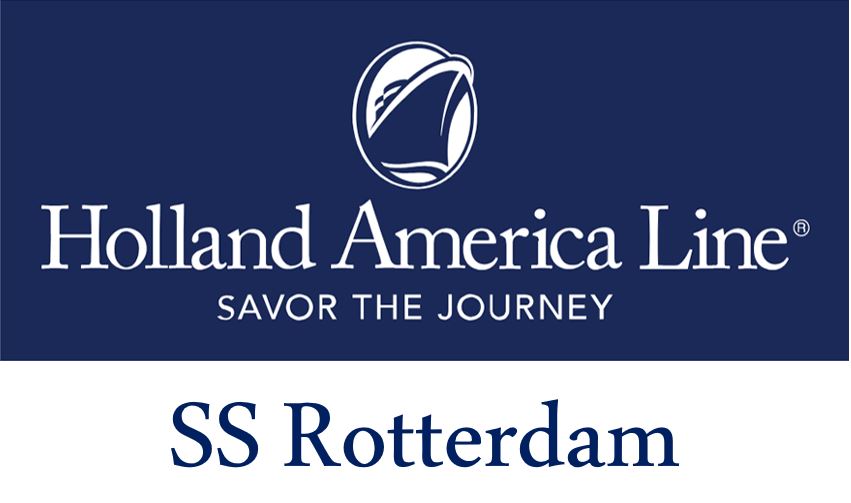
Holland America Line (HAL) was founded in 1873 in Rotterdam, Netherlands. When it began, it started as a Dutch shipping line, then became a passenger line (carrying passengers and cargo), followed by a cargo line and is now a cruise line. It has a history of operating primarily between the Netherlands and North America. Recently, it was announced that their newest ship to be launched in 2021 had been given a new old name, Rotterdam, so I began the research process. Next thing I know, I’m diving deep into the seven ships that have all sailed with the name Rotterdam over the past 150 years! Welcome to this week’s rabbit-hole adventure as we discover and uncover the history of the most famous ship name to come from Holland America Line.
I. 1872 – 1883
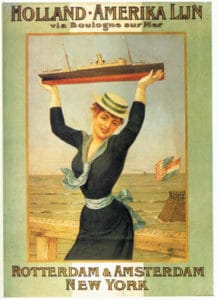
In 1872, there was a new ship being built called the SS Rotterdam. She was built at the Henderson, Coulborn and Company shipyard in Renfrew, Scotland, United Kingdom. Launched in June of 1872, she was 268 feet long, had a beam of 35 feet and depth of 28 feet. She was a little girl at 1,694 Gross Registered Tons (GRT) with 2 decks. Not only did she have engine propulsion, but also utilized 10 sails to get moving.
Her maiden voyage was on the 15th of October in 1872, sailing from Rotterdam, The Netherlands to New York, United States. There were 10 cabin class passengers, 60 emigrants and 600 tons of cargo. It took just over 14 days to complete the journey and would make the return trip to Rotterdam on November 5th.
In 1879, she encountered inclement weather causing considerable damage to her foremast and steerage quarters, deeming them completely wrecked. There were no casualties reported and it delayed her journey to New York by 6 days. In spring 1883, she was refurbished and received new boilers thereby improving the fuel consumption considerably.
On September 26th, 1883, SS Rotterdam was traveling on her 65th voyage from New York to Rotterdam. She ended up running ashore on a Dutch island. All 56 passengers were evacuated by a local lifeboat and made it safely ashore. The crew arrived shortly after via tugboat. About one month later, the SS Rotterdam sank due to her proximity to the shoreline and being pounded by stormy weather at sea.
II. 1886 – 1895
In 1878, a 19-century ocean-going steamer was constructed by the shipbuilding firm, Harland and Wolff. She weighed in at 3,361 GRT and was originally named British Empire while she sailed with British Ship Owners Co. and operated by the American Line. In 1886, she was sold to the Dutch-American Steamship Company, more commonly known as the Holland America Line. She adopted the familiar name when she was purchased and sailed as the SS Rotterdam following the Rotterdam-New York City route. The route was modified in 1890 to become Amsterdam to New York City.
In 1895, she was pulled out of service to get some work done and at the end of the dry dock, she emerged as the SS Edam and continued to sail with HAL, ferrying passengers and cargo across the Atlantic Ocean until 1899, when she was scrapped in Italy.
III. 1897 – 1906
By the year 1897, the third SS Rotterdam had entered service for HAL. This ship assumed the Rotterdam to New York City route at a cool 14 knots. She was larger than her predecessors weighing in at 8,173 GRT at 496 feet long, 53.1 foot beam and a depth of 22.7 feet. She was equipped with a triple-expansion steam engine and was built to haul 200 first class passengers, 150 second class passengers and 2,000 third class. She was built by Harland & Wolff in Belfast and made her maiden voyage on August 18, 1897. Her final route began on February 17th, 1906.
After she was retired from HAL, she was transferred over to the Scandinavian America Line and renamed C. F. Tietgen. In 1913, she was sold again to a different line called Russian American Line and was renamed Dwinsk. She met her demise in 1918 when she was struck by a torpedo from the German U-151. She ended up sinking and all but 22 people survived the tragedy.
IV. 1908 – 1939
Prior to the launch of this ship, all previous iterations of the SS Rotterdam were under 10,000 GRT. Holland America Line moved towards a new strategy in 1906 when they ordered a new Rotterdam weighing in at 23,000 GRT to be built at Harland and Wolff shipyard. Her maiden voyage was in June 1908 with 75 first class passengers, 82 second class, and 128 third class passengers. This was a far cry from what this ship could handle: 525 first class, 515 second class and 2,400 third class passengers for a total of 3,440. From a crew perspective, she had 51 people serving on deck, 119 on the machinery, and 302 in civilian service for a total of 472 people.
Continuing the tradition of previous ships donning this name, the 1908 Rotterdam made treks from Rotterdam to New York City and back until 1914, when HAL started to introduce a leisure route for their fleet. In February of 1914, Rotterdam left New York for a cruise to the Mediterranean with 842 first class passengers. She made calls at Cadiz, Gibraltar, Algiers, Athene, Istanbul, Jaffa, Alexandria, Naples, Villefranche-sur-Mer, and Boulogne.
By September of 1914, SS Rotterdam had switched gears to provide assistance with World War I. She began by transporting many of the 45,000 American civilians that got stuck in Germany or Switzerland back to the United States. Passenger service had nearly come to a standstill during this time so she began to carry more cargo from cotton to mail to gold and coffee.
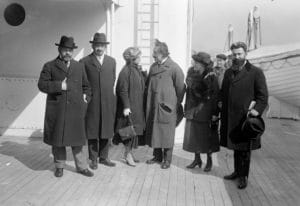
Photo: Wikipedia.org
In the 1920s the Rotterdam returned to full cruise service calling in New York and the Mediterranean. During one of her routine trips, the fourth iteration of the SS Rotterdam carried a very special passenger to New York. This passenger was Albert Einstein.
In 1929 she was renovated to have two passenger classes rather than three. By 1939 she had been laid up in Rotterdam after traveling the distance of 70 times the circumference of the earth. The next year, she was broken up.
V. 1958 – 1997
Also known as “The Grande Dame,” the fifth SS Rotterdam launched on September 13, 1958 and was christened by Queen Juliana. Originally, she was conceived to run alongside Nieuw Amsterdam which was launched in 1937, however due to World War II in Europe, she was delayed until economic conditions became favorable for a new ship in 1954. This was the beginning of the end of ocean liners as basic transport. Designers took this into mind when creating this vessel and distinguished a two-class system, horizontally divided with movable partitions and a unique double staircase to allow for easy conversion to cruising. All of the machinery on this ship were shifted aft to a now-traditional two thirds aft position and rather than building just a single funnel, there were twin uptake pipes installed.
With the growing leisure market, air travel was becoming more popular, which meant that transatlantic liners were no longer in use. This trend caused the Rotterdam to permanently stop conducting transatlantic service in 1969. There was a small retrofit completed as part of this change, to become a single-class cruise ship.
This particular vessel gained popularity in the 1970s and early 1980s, carrying a lot of American and Australian passengers. In 1977 there was another refit where her capacity was reduced from 1,499 to 1,144 and by the 1980s, SS Rotterdam was doing routine Caribbean winter sailings and summers were spent in Alaska. Holland America Line was taken over by Carnival Cruise Lines in 1989.
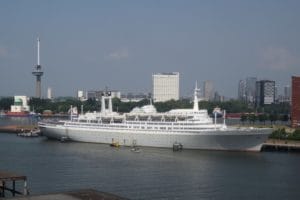
Photo: https://www.stoomschiprotterdam.nl/en/
SS Rotterdam remained in service until 1997 when it was discovered that it would cost $40 million to upgrade her to meet ADA compliance requirements. Her final sailing with HAL was on September 30, 1997. She was then sold to Premier Cruises and renamed SS Rembrandt (you can read all about that in a previous Weekly Wednesday – Premier Cruises). She returned to the city of Rotterdam and had her name changed back to the previous in 2008. She underwent restoration and opened in February 2010 as a hotel (SS Rotterdam), museum and school for vocational training.
VI. 1997 – 2020
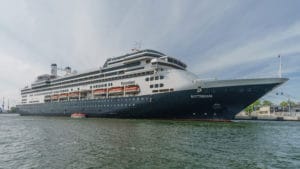
By November of 1997, the sixth Rotterdam was launched. She was the largest of the series, weighing in at 61,849 GRT with a length of 780 feet and beam of 105.8 feet. She was capable of carrying 1,404 passengers and had 600 crew onboard. The launch of this ship introduced the Rotterdam Class (R Class) of ships for Holland America Line. Unlike the first class of ships, the Statendam Class, the R Class fleet all had very similar features to them and consisted of four ships: MS Rotterdam, MS Volendam, MS Zaandam, and MS Amsterdam.
In September 2004, the Rotterdam got stuck in a hurricane while doing a transatlantic crossing. All four engines stopped working and power was temporarily lost as the ship was stuck in storm swells reaching 49 feet tall. There were many injuries onboard with the most severe being fractured bones. She eventually regained power and continued the journey to Halifax, Nova Scotia.
The first standalone transatlantic crossing since 1971 took place on the sixth Rotterdam during the summer of 2011. During this series of trips, she completed the journey both eastbound and westbound, returning to HAL’s original cruising pattern for that season.
In July 2020, it was announced that MS Rotterdam had been sold to Fred. Olsen Cruise Lines as Holland America Line worked to downsize its fleet size amid the COVID-19 pandemic. She was sold along with her younger sister, MS Amsterdam.
VII. 2021
The third Pinnacle Class ship was announced in January 2017. Construction had begun on MS Ryndam in March 2019 which is set to be 99,500 GRT and be able to carry 2,660 passengers. Upon the retirement announcement of the MS Rotterdam in July of 2020, HAL made the decision to rename MS Ryndam to MS Rotterdam, resurrecting the name for a seventh time. Scheduled to launch in August of 2021, she will be sailing out of Amsterdam to begin, cruising Northern Europe and will eventually shift to the Caribbean by October for her North American debut.
In Conclusion
Will there be more ships named Rotterdam? It’s almost inevitable, however with Holland America Line building this one brand new, this iteration will most likely remain in service for at least 20 years. Seeing a cruise line that is so dedicated to its roots is really refreshing! Have you sailed on any of the Rotterdams under HAL? What was your experience like? They are usually the flagship in the fleet when they make their debut due to the respect the cruise line has for its origins.
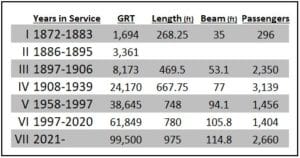
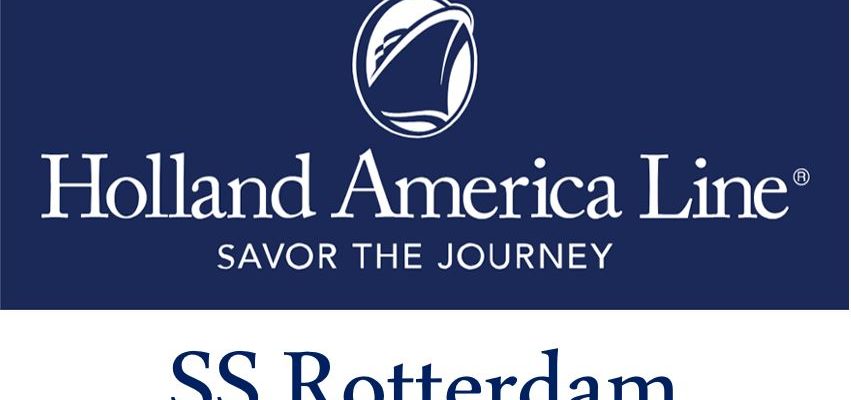
My wife and I sailed on the last eastbound voyage of the S.S. Rotterdam from San Diego through the Panama Canal to Fort Lauderdale just before the pandemic struck. We arrived in Fort Lauderdale on February 24, 2020. I believe the ship made one more west bound voyage through the Panama Canal and then it went to South America in order to help rescue passengers stranded on ships during the COVID outbreak.
My grandmother was on the last voyage on February 17, 1906 of the third S.S. Rotterdam when she immigrated to America from Russia. She traveled from Rotterdam to New York
Thank you for sharing your heart-warming story about your family’s experiences on board the Rotterdam. It’s inspiring to hear about the connection that you shared with your grandmother having sailed on the same-named ship decades earlier!